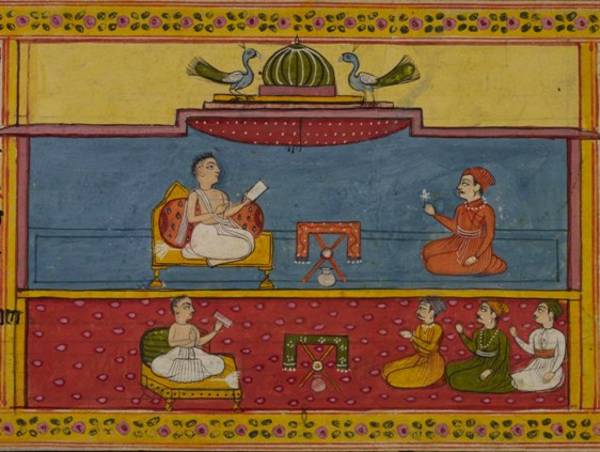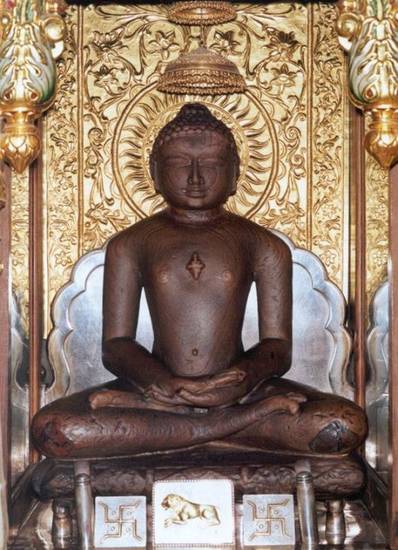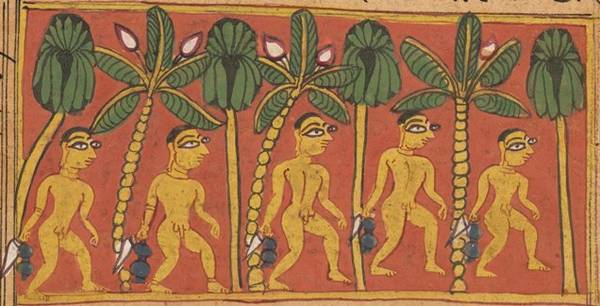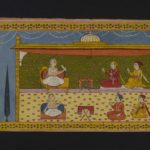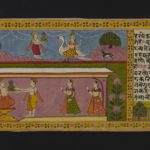Article: Digambara
Followers of the Jinas can be categorised into various sects or traditions. All religions have developed similar divisions, often disagreeing on elements of belief and practice. All these groupings remain believers in the central doctrines of the religion. Towards the beginning of the Common Era, the Jains started to separate into two main groups. The disputes between these groups revolved around the practices and doctrine surrounding mendicants. The two sects of Digambara and Śvetāmbara Jains take their titles from the clothing practices of their monks.
These groupings slowly elaborated distinct doctrines and histories, with diverse canons of scriptures and significant figures. The principal sects each contain smaller subsects, which split from the original sect over disagreements regarding doctrine and practice.
Sects are usually based on monastic lineages. Tracing sectarian development is particularly difficult for the Digambara tradition. Records kept by mendicant orders – paṭṭāvalis or gurv-āvalis – form the largest body of documentary evidence for the development of sects. However, Digambara orders are based in large part on the individual monk and his followers and thus record-keeping is not considered vital.
Regardless of the importance of individual mendicants in the development of Digambara Jainism, significant subsects originated within the lay community, such as the Taraṇ Svāmī Panth, the Terā-panth and Bīs-panth.
This piece is a summary of the article "Digambara". The full article will be available soon.
Terms
Digambara Jains tend to commonly use the following Sanskrit words for a ‘sect’:
The label saṅgha can refer to two concepts. Firstly, saṅgha can mean the ‘fourfold community’, which comprises monks, nuns, lay men and lay women. Its second meaning describes the ‘monastic community’ – sādhu-saṅgha or muni-saṅgha.
Both meaning ‘group’, the words gaṇa or gaccha are most commonly used for ‘monastic orders’. Most Digambaras tend to prefer gaṇa.
Main characteristics
The Digambara sect is named after one particular practice of its monks.
The monks live naked, following the example of the Jinas and their monastic disciples, who they believe rejected clothing as part of their renunciation of all worldly attachments. They are thus ‘clothed’ – ambara – in ‘the directions’ or ‘the sky’ – dik or dig. The sect is therefore known as Digambara, from the Sanskrit phrase meaning ‘sky-clad’. Only full monks – munis – go naked, as it is recognised as a test of complete detachment. Novice monks wear some clothing.
Female ascetics wear white garments. Forbidden to go naked, they are unable to renounce as fully as men so they are technically lay women who have taken advanced vows.
|
Male mendicant clothing |
|
|---|---|
|
Female mendicant clothing |
|
|
|
|
|
|
Women |
cannot achieve liberation |
|
Sex of Jinas |
all Jinas are male |
|
Images of Jinas |
|
Digambara sectarian traditions
Full Digambara monks are rare these days. The early tradition of an individual monk’s gathering pupils continues in the present day. Digambara monks ‘seem to have an especially weak sense of standard training, of a line of pupillary succession, or of allegiance to an order’ (Carrithers 1989: 230). Junior monks follow a muni, who guides them in their spiritual development. An individual monk is expected to influence junior mendicants and lay people through his learning, personal example and charisma rather than through an official post or discipleship to a famous monk.
The emphasis on individual leaders rather than rule-based succession is likely to have been the case in the past too, though it would have been more complex when monks were more common. Establishing mendicant relationships of the past is even more complicated when the evidence for many Digambara monastic orders is so fragmentary. However, geographical location seems to be a strong factor in the foundation of sects. Dundas (2002: 121) highlights ‘the complexity of medieval Digambara ascetic organisation in which a plethora of sects and subsects, many of them totally obscure to us today, emerged on the basis of preceptorial association and geographical connection with particular regions and towns’.
The institution of the bhaṭṭāraka intensifies the involved nature of Digambara sectarian development. The various bhaṭṭārakas each have their own lineage. Attached to particular places, the bhaṭṭārakas cut across the influence of the wandering mendicants. Their longstanding presence tended to consolidate the Digambara tradition in certain areas and helped ensure its long-term survival.
Historical lineages
The earliest Digambara community was the Mūla-sangha – ‘the Root Assembly’. It is said to go back to the 24th Jina, Mahāvīra, through Kundakunda, the most authoritative teacher for the Digambaras, who lived around the second to third centuries CE.
Available accounts, however, show that this main lineage split into four groups – gaṇas:
- Sena-gaṇa
- Deva-gaṇa
- Siṃha-gaṇa
- Nandi-gaṇa.
These four groups fractured into subdivisions. Each of these produced lineage texts – paṭṭāvalis – that are rather complex because they often reflect different traditions for the same sections of mendicant orders. One of the most developed monastic lineages is the Sarasvatī-gaccha.
The Mūla-sangha seems to have been influential in all the regions where Digambara communities existed from around the fifth to sixth centuries until very late. This is borne out by inscriptions, manuscript colophons and monastic lineages.
Another group was the Drāviḍa-sangha – ‘Dravidian Assembly’. It was founded by Vajranandin in the fifh century CE at Madurai, in Tamil Nadu. There are hints that mendicants of this group may have given up the traditional wandering life.
The Kāṣṭhā-sangha was another group that might have arisen in the seventh century. Its title could be related to a place name. One of their characteristics seems to have been the use of cow-tail brooms instead of the peacock-feather brooms of other Digambara mendicants.
Contemporary lineages
Information on today’s lineages and their organisation is scarce. But these earlier divisions do not seem to be in force nowadays. Today’s Digambara monastic community goes back to six groups that existed in the late 19th to early 20th centuries. Of these only the following three have survived to the present time (Flügel 2006: 350):
The following table, giving the numbers of Digambara monks and nuns in 2000 and 2001, is based on the information on page 355 of Flügel 2006.
|
Year |
Male ascetics |
Female ascetics |
Total |
|---|---|---|---|
|
2000 |
453 |
365 |
818 |
|
2001 |
508 |
394 |
902 |
Bhaṭṭāraka monks
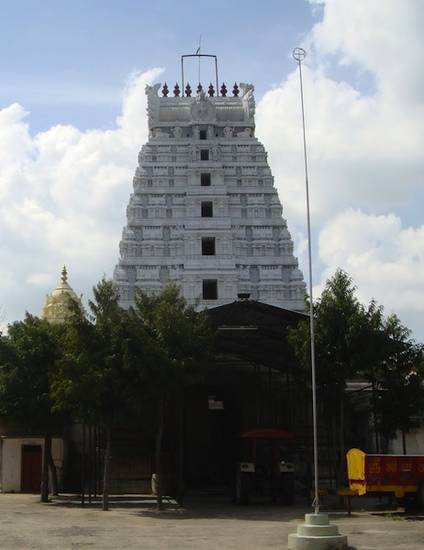
Maṭha in Melsittamur
Image by Vijayan Teacher © CC BY-SA 3.0
Among Digambaras in southern India, where this sect was historically concentrated, along with central India, there is a special type of monk. The bhaṭṭāraka – ‘venerable one’ or ‘learned one’ in Sanskrit – is not bound by the usual mendicant vows.
The bhaṭṭārakas do not practise nudity. They also differ from usual Digambara monks in that they live in a monastery instead of taking up the wandering life, travel using mechanised transport, own lands and estates and act as a kind of community manager.
The longstanding existence of a monastery – maṭha – in an area means that each has developed its own lineage. Successive bhaṭṭārakas have gradually accrued local and influence and have often been a significant regional power. This has contributed to the survival of the Digambara sect, especially when foreign rulers disapproved of the tradition of public nudity.
Lay traditions

Woman praying
Image by Chandu Shah © Chandu Shah
Sects seem to have followed a similar pattern of development as they originated. Most new sects grow up around a mendicant order that emerges. Strictly speaking, lay Jains are not members of sects because only monks and nuns belong to mendicant orders, which form the groupings known as sects. Lay Jains tend to follow mendicants who claim affiliation with certain monastic orders.
Despite this pattern, new sects have arisen that have lay founders or are oriented more towards lay people than mendicants. Some traditions have been established by men who were lay renunciates, not initiated monks. Other traditions have been founded by mendicants but have not produced monastic lineages.
The three lay traditions in the Digambara sect all originated in the northern and central regions of India. As their characteristic features relate to the practice of worship rituals, this was probably an important point in areas where Digambara Jains were smaller in number.
Taraṇ Svāmī Panth

Jain holy texts
Image by Malaiya © CC BY-SA 3.0
Members of the Taraṇ Svāmī Panth are the lay followers of Taraṇ Svāmī (1448–1515), a Digambara thinker who ‘took the vows of a celibate and thereby became a formal renouncer’ (Cort 2006: 265). In a period where full-fledged naked Digambara monks were rare, such celibate renouncers had an important role to play. Taraṇ Svāmī became a full Digambara monk at the end of his life. He has been presented as a ‘Digambara mystic, as Digambara ritual reformer, as trans-sectarian iconoclastic poet, as miracle-worker, and as Jina-to-be’ (Cort 2006: 267).
Taraṇ Svāmī is the author of 14 writings, the main message of which is that one has to realise the ultimate purity of the soul as being the liberated soul. This is in line with the teachings of Kundakunda.
There is, however, no continuous literary tradition, so that nothing is known of the period between Taraṇ Svāmi’s death and the 20th century.
Today followers of this lay path, the Taraṇ Svāmi Panthins, are mainly found in central India, especially in the historical area of Bundelkhand, in Madhya Pradesh. Numbering between 20,000 and 100,000, they do not worship Jina images, although their founder’s writings do not seem to really criticise this. Instead they venerate books by Taraṇ Svāmi and Kundakunda and also other Digambara scriptures, especially those that stress the nature of the soul.
Kundakunda’s Samaya-sāra is a key text so this movement is also called Sāmāiya-panth – ‘the Path of Sacred Books’. Books and not images are the objects of worship in their temples. The most important temple is known as ‘Nisaījī’, near the village of Malhargarh in Guna district. It is a memorial, as it was the place where the founder spent the last years of his life and died.
Rajneesh, alias Osho (1931–90), an internationally known Indian holy man, was born in a family that followed the Taraṇ Svāmī Panth (Cort 2006: 293ff.).
Terā-panth and Bīs-panth
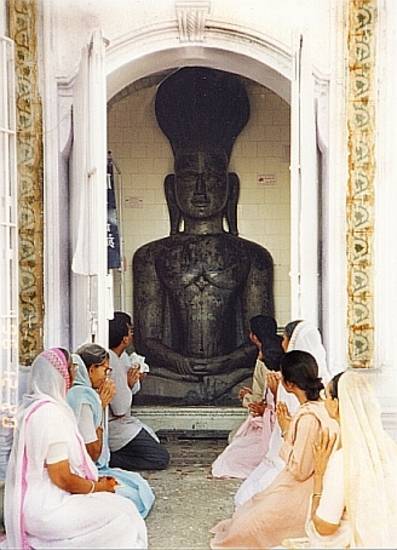
Lay people worship a Jina
Image by Sheetal Shah © Sheetal Shah
These two Digambara groups are found among the lay communities of north India. Since this division refers chiefly to rituals of worship, it does not really apply to Digambara monastic communities. As full renunciates, they do not perform worship in the same way as lay people.
However, there have been cases of Digambara mendicants being associated with a specific monastery headed by a bhaṭṭāraka. The institution of the bhaṭṭārakas started to be challenged and criticised in 17th-century India, when this division between the two sects emerged. The development of the Terā-panthins and Bīs-panthins thus had some impact on mendicants as well. There was no such challenge in south India and therefore these subsects do not exist there.
Comparing the two subsects, Terā-panthins may be regarded as having views that are more radical or less compromising than Bīs-panthins.
|
Terā-panthins |
Bīs-panthins |
|---|---|
|
Reject the authority of the Digambara clerics – the bhaṭṭārakas |
Accept the authority of the bhaṭtārakas |
|
Worship Jina images |
Worship Jina images |
|
Do not worship images of deities that have not achieved liberation, such as yakṣas, yakṣīs and kṣetrapālas |
Worship images of deities, who are unliberated |
|
Worshippers do not use any substance considered to contain life in rituals |
Worshippers offer the eight objects, such as flowers, fruits and sandalwood |
|
The lamp ceremony is not performed |
The lamp ceremony is performed |
|
Followers worship while standing rather than while seated |
Followers worship while seated or standing |
Adhyātma movement
Of Digambara inspiration, this movement arose in Agra and other north Indian cities during the 16th to 18th centuries among lay men who met to discuss scriptures. One of its leaders was Banārasīdās.
Never organised as a sect, it is probably best described as free-thinking circles of thoughtful and slightly rebellious lay men who questioned some points of the scriptures and rituals.
Reading
- ‘Naked Ascetics in Southern Digambar Jainism’
Michael Carrithers - Man (New Series)
volume 24: 2
Royal Anthropological Institute of Great Britain and Ireland; June 1989
- ‘A Tale of Two Cities: On the Origins of Digambar Sectarianism in North India’
John E. Cort - Multiple Histories: Culture and Society in the Study of Rajasthan
edited by Lawrence A. Babb, Varsha Joshi and Michael W. Meister
Rawat Publications; Jaipur, Rajasthan, India; 2002
- ‘A Fifteenth-Century Digambar Jain Mystic and his Followers: Tāraṇ Taraṇ Svāmī and the Tāraṇ Svāmi Panth’
John E. Cort - Studies in Jaina History and Culture: Disputes and Dialogues
edited by Peter Flügel
Routledge Advances in Jaina Studies series; volume 1
Routledge Curzon Press; London, UK; 2006
- History of Jaina Monachism from Inscriptions and Literature
Shantaram Bhalchandra Deo - Deccan College Dissertation series; volume 17
Deccan College Postgraduate and Research Institute; Pune, Maharashtra, India; 1956
- The Jains
Paul Dundas - Library of Religious Beliefs and Practices series; series editor John Hinnels and Ninian Smart; volume 14
Routledge Curzon Press; London, UK; 2002
- The Jaina Path of Purification
Padmanabh S. Jaini - University of California Press; Berkeley, California USA; 1979
- Gender and Salvation: Jaina Debates on the Spiritual Liberation of Women
Padmanabh S. Jaini - University of California Press; Berkeley, California, USA; 1991
- Bhaṭṭāraka Sampradāya: A History of the Bhaṭtāraka Pīṭhas especially of Western India, Gujarat, Rajasthan and Madhya Pradesh
Vidyādhara P. Joharāpurakara - volume 8
Jīvarāja Jaina Granthamālā; Sholapur, Maharashtra, India; 1958
- ‘Rethinking Religious Authority: A Perspective on the Followers of Śrīmad Rājacandra’
Emma Salter - Studies in Jaina History and Culture: Disputes and Dialogues
edited by Peter Flügel
Routledge Advances in Jaina Studies series; volume 1
Routledge Curzon Press; London, UK; 2006
- ‘The Revival of the Digambara Muni Tradition in Karnataka during the Twentieth Century’
Sabine Scholz - The Jaina Heritage: Distinction, Decline and Resilience
edited by Julia A. B. Hegewald
South Asian and Comparative Studies Heidelberg series; volume 2
Samskriti; New Delhi, India; 2011
- The Unknown Pilgrims: The voice of the sādhvīs – the history, spirituality, and life of the Jaina women ascetics
N. Shāntā - translated by Mary Rogers
Sri Garib Dass Oriental series; volume 219
Sri Satguru Publications; New Delhi, India; 1997
- Historical Dictionary of Jainism
Kristi L. Wiley - Historical Dictionaries of Religions, Philosophies, and Movements series; series editor Jon Woronoff; volume 53
Scarecrow Press; Maryland, USA; 2004
Links
- Images of Shravana Belgola
-
The best-known Digambara pilgrimage site, Shravana Belgola in Karnataka is centred around the immense statue of Bahūbali. Depicted standing in deep meditation, the statue has drawn pilgrims and interest from visitors since the tenth century. This collection of drawings and photographs is presented by Professor Frances W. Pritchett of Columbia University in New York.
- Statue of a meditating Jina
-
This idol of a Jina shows him in the characteristic lotus position of meditation. He has a serene half-smile on his face, elongated earlobes and curly hair. The severe style and lack of clothing indicates that the 11th-century statue belongs to the sect of the Digambaras. It may depict the 24th Jina, Mahāvīra. The photograph provided by the Philadelphia Museum of Art is accompanied by a brief audio commentary on the statue.
http://www.philamuseum.org/collections/permanent/64704.html?mulR=10908|7
- Digambara nuns pluck out their hair
-
In the keśa-loca rite, part of the renunciation ceremony of dīkṣā, new monks and nuns pull out their hair, which indicates indifference to worldly concerns, including pain. Ashes are smeared on the roots of the hair, making it easier to pluck out and reducing pain. In the Digambara sects, keśa-loca is a public ceremony. This rite took place among Digambara nuns, as shown by the peacock-feather broom – piñchī – one of them holds in this YouTube video. The dīkṣā was conferred by the nun Gaṇinī Āryikā Viśuddhamati mātājī in Kota, Rajasthan, a few years ago, though the precise date is unknown. The language used is Hindi, with Sanskrit and Prakrit for recitations from the scriptures.
- Bāhubali statue details
-
Details of the colossus of the great saint Bāhubali at Shravana Belgola shown in this 2009 YouTube video. The serene expression of the naked statue and the plants growing round his body can be clearly seen. The granite figure, showing Bāhubali deep in meditation, has attracted countless pilgrims since its dedication in 981. Most are Digambara Jains, though Bāhubali is revered by all sects.
- Nandīśvara-dvīpa brass sculpture
-
This freestanding brass sculpture depicts the mythical continent of Nandīśvara, where the gods go to perform religious duties. Depictions of Nandīśvara-dvīpa are frequently worshipped among the Digambara sect, but a metal image is rare. The sculpture features 52 Jinas, both sitting and standing. This piece of art is described as part of a lot auctioned by Christie's in 2002.
- Views of temples at Mukta-giri
-
The Digambara temple-city of Mukta-giri has 52 temples. Found in Madhya Pradesh, this popular pilgrimage attraction is built in a valley instead of on a high place more usual for holy sites. These images are presented by Professor Frances W. Pritchett of Columbia University in New York.
- Dreams of Triśalā
-
Jainworld.com provides pictures and explanations of the dreams of Queen Triśalā. Women carrying babies who grow up to become Jinas all experience auspicious dreams, which signal the great spiritual leadership of their children. The Digambara sect specifies 16 dreams while the Śvetāmbaras have14 dreams.
- List of Digambara holy places
-
Jainteerth.com provides a list of Digambara holy places in India, complete with details of the main temple and idol, location, travel information, facilities for pilgrims and contact details of the management organisation. The site also offers background information on temples and Jain principles. Unfortunately, the standard of English is not very good.
- Digambaras celebrate Mahāvīr Jayanti
-
This 2009 YouTube video shows a Mahāvīr Jayanti celebration in the temple in Indore, Madhya Pradesh. Digambara novice monks carry an idol of Mahāvīra in the centre of a colourful procession. Lay people perform rās-garba dances with sticks. A local lay man and his wife, who ride an elephant in this celebration, play the king and queen of the gods. The annual festival commemorates the birth of the 24th Jina, Mahāvīra.
- Seven Wonders of India – Shravanabelagola
-
The Digambara pilgrimage site of Shravana Belagola in Karnataka is the subject of this NDTV video on YouTube. The presenter gives a brief history of the site and the story of Bāhubali, whose huge statue is the focus of worship. Some pilgrims in ill health are carried in sedan chairs up and down the steep hill, atop which stands the Bāhubali colossus. Inscriptions protected by heavy sheets of glass are shown. Pilgrims performing worship rituals are filmed, including the sacred bath or ‘head-anointing ceremony’ – mastakābhiṣeka – of a small metal image of Gommaṭeśvara or Bāhubali.
The New Delhi Television show Seven Wonders of India asked viewers to vote for their favourite seven sites in the country. It was part of a publicity campaign organised by the Ministry of Tourism in 2008 to 2009. The show's presenters visited many sites considered potential winners.
- A Jina sits in meditation
-
The National Gallery of Australia provides this 12th-century image of a seated Jina. Under an ornate arch, the Jina takes the lotus pose of meditation. He is hard to identify without his emblem – lāñchana – but his closed eyes, unadorned figure and nudity indicate the statue was produced by the Digambara sect.
http://artsearch.nga.gov.au/Detail-LRG.cfm?IRN=128702&View=LRG
- Āryikā Jñānamati – Jain Triple World Research Institute
-
One of the most influential women in contemporary Jainism, Āryikā Jñānamati is a Digambara nun. Her achievements and character inspired the 1974 foundation of the Digambar Jain Trilok Shodh Sansthan – Jain Triple World Research Institute – in Hastinapur, Uttar Pradesh. Here described by her name in modern Hindi, Āryikā Jñānamati is profiled on the institute's website.
- Procession of Mahāvīra idol
-
This 2009 YouTube video shows the procession of a small golden idol of Mahāvīra – rathayātrā – through the streets of New Delhi. The procession takes place during the Digambara festival of Daśa-lakṣaṇa-parvan. The men in orange, some of whom are also crowned, are the prominent lay men who have won the privilege of accompanying the statue in the procession. They put the statue in an ornate shrine on a platform set on a tractor with false horses attached. Before the procession begins, Jain lay women move trays of fire in circles – āratī – offering pūja or worship to the idol. Lay people dance in the procession around the idol, which is fanned by fly-whisks, a sign of high status. Many of the dancers wave bright plastic objects, which are modern equivalents of traditional fly-whisks. The women dressed in orange are the wives of the prominent lay men on the tractor. A model of Bāhubali with vines creeping up his legs is also fanned. Small children ride on the shrine, which is hung with a Jain flag at the back, while musicians and models form part of the procession. Two fully fledged monks take part, accompanied by novice monks in white. At the end of the procession the idol is taken into the temple, placed in front of a large Jina image and given a sacred bath. Food is provided for the participants afterwards. All along, there are various songs or prayers. In the first part, the Pañca-namaskāra-mantra is sung to various tunes, then come hymns in Hindi. For instance, one of them says: ‘Listen to the voice of the Jinas’.
- Pilgrimage site of Shravana Belgola
-
This YouTube video shows the Digambara pilgrimage site of Shravana Belgola in Karnataka. Centred on the 18-metre-tall Bāhubali statue at the top of Vindhya-giri, the site also has many temples and holy spots. A small metal image of Gommaṭeśvara or Bāhubali sits at the feet of the colossus, which is flanked by two female figures. The video was uploaded in 2010 by Indiavideodotorg.
- Śruta-pañcamī – part 1
-
Some features of the annual Digambara festival of knowledge – Śruta-pañcamī – are demonstrated in this YouTube video, such as the worship ritual and the procession of holy texts. Temple rites include the ritual anointment of freestanding metal plaques representing holy texts and idols, accompanied by jangling percussion. The main part of the ritual shown in this video centres around the worship of the śruta-skandha-yantra, a plaque made of brass in the form of a tree, which represents the kinds of scriptures Digambaras recognise. Carried in procession, the sacred books are garlanded with flowers and flanked by attendants using fly-whisks, which indicate the princely status of the artefacts, while devotees kneel before a naked monk and touch his feet. The Ṣaṭkhaṇḍāgama, the main authoritative source of Digambara teachings, is the book worshipped here.
This three-part YouTube video records the festival at Mudalur, Tamil Nadu in India, held over 28th and 29th May 2009. This is the first part and you can watch the second part at: http://www.youtube.com/watch?v=M-I9AYjIcAc
- Śruta-pañcamī – part 2
-
The procession of holy texts in the annual Digambara festival of knowledge – Śruta-pañcamī – is the main subject of this YouTube video. As the centre of festivities, the sacred books are decorated with flower garlands. They are placed on a model elephant, protected from the sun by a canopy and fanned with fly-whisks, all symbols of royalty. The Jain flag is waved in front. Lay Jains, many dressed in orange – the colour of spirituality in India – take part in the noisy procession. Some carry the metal sculptures of the 12 dreams of a Jina’s birth. A nude monk, holding his peacock-feather broom, and white-clad nuns also participate. The procession ends with a display of holy books, the reflection of which is ritually anointed, and a rite of worship in which the auspicious symbol of the svastika can be clearly seen.
This three-part YouTube video records the festival at Mudalur, Tamil Nadu in India, held over 28th and 29th May 2009. This is the second part and you can watch the last part at: http://www.youtube.com/watch?v=zR21K-vcp5U
- Śruta-pañcamī – part 3
-
This YouTube video follows the end of the first day’s events of the annual Digambara festival of knowledge – Śruta-pañcamī. First, a rite of worship before a brightly coloured rangoli – a design of coloured powder or rice symbolising joy and welcome – is performed. The lay community files past the rangoli and metal sculpture representing knowledge while monks and lay people chant a Sanskrit hymn. This song praises knowledge, omniscience, the scriptures and the goddess Sarasvatī, who embodies knowledge. Behind the rangoli piles of holy books can be seen, which have been carried in procession through the village as guides to knowledge. After the fire ritual, an inititation ceremony – dīkṣā – of a new monk, featuring keśa-loca – ‘pulling out of the hair’ – takes place before the crowd. Afterwards, they move trays of fire in circles – āratī – offering pūja or worship to the new mendicant. An anointing ceremony – abhiṣeka – of the māna-stambha pillar found in front of Jain temples follows, with a final procession past the symbols of knowledge.
This three-part YouTube video records the festival at Mudalur, Tamil Nadu in India, held over 28th and 29th May 2009. This is the final part and you can watch the first part at: http://www.youtube.com/watch?v=5S2bcehoy-U
- Digambara monk takes alms from lay women
-
This video on YouTube shows a Digambara monk eating alms offered by lay women. The women gather round and put spoonfuls of food into his cupped hands. He moves his thumbs quickly through it to ensure it is pure enough to eat.
- Mahāvīr Jayantī procession – part two
-
The festival of Mahāvīr Jayantī is often marked with a procession in which images of the 24th Jina Mahāvīra are carried through the streets. This large procession is made up of animals, musicians and singers, dancers and local Jains celebrating the birth of the last Jina. People perform worship in front of the image. Children dressed in white represent monks and nuns while others re-enact scenes associated with Mahāvīra’s birth. Nude Digambara monks stand out in the crowd. This procession took place in March 2010 in Jaipur, Rajasthan and also featured the message of environmental conservation.
Captured in two parts on YouTube, this is the second part. You can also watch the first part.
- Mahāvīr Jayantī procession – part one
-
The festival of Mahāvīr Jayantī is often marked with a procession in which images of the 24th Jina Mahāvīra are carried through the streets. This large procession is made up of animals, singers and musicians, dancers and local Jains celebrating the birth of the last Jina. This procession took place in March 2010 in Jaipur, Rajasthan and also featured the message of environmental conservation.
Captured in two parts on YouTube, this is the first part. You can also watch the second part.
- Hymn to Naminātha
-
This 2007 hymn on YouTube is a Sanskrit stotra to the 21st Jina, Naminātha or Lord Nami. The sound is accompanied by pictures of statues of Jinas and monks of various Jain sects. The plain statues of nude Jinas with closed eyes and the naked monks belong to Digambara sects. The white-robed mendicants are Śvetāmbara Mūrtipūjakas. The monks and nuns with mouth-cloths attached to their ears are from either the Terāpanthin or Sthānaka-vāsīn Śvetāmbara sects.
- Group initiation of Digambara monks – part 1
-
After studying with him for four years, 25 men are initiated into Digambara monkhood by the monk Vidyāsāgar. At the start of the public renunciation ceremony – dīkṣā – the candidates resemble grooms, wearing jewels and turbans, their eyes outlined in kohl. They are then seen after the rite of keśa-loca. Dressed in orange and saffron robes, lay Jains dance in celebration. Scenes from the life of a Digambara monk are also shown, such as the monk carrying his broom and water pot, making the gesture to signal that he seeks alms. A group of fully nude monks leads the ailaka novices in loincloths, followed by the junior novices wearing white robes. Digambara nuns, wearing the white robe and holding the broom made of peacock feathers, are also shown in this YouTube video. This collective ceremony in Hindi took place on 21 August 2004 in the so-called Dayoday Tirth, Delwara Ghat, in the town of Jabalpur in Madhya Pradesh on the bank of the river Narmada. Watch the dīkṣā ceremony continue at: http://www.youtube.com/watch?v=zFfMGtC7zfI&NR=1
- Group initiation of Digambara monks – part 2
-
As part of their group ceremony of renunciation – dīkṣā – novice monks have the last tufts of hair plucked out by their teacher Vidyāsāgar. Then they remove their clothes amid the rejoicing of the large crowd of lay Jains. As a sign of detachment from worldly affairs, public nudity is associated with advanced spirituality and is the mark of a fully-fledged monk in Digambara Jainism. Then Vidyāsāgar traces the auspicious symbols of svastikas and four dots on their heads in sandalwood paste. Found on YouTube, this collective ceremony in Hindi took place on 21 August 2004 in the so-called Dayoday Tirth, Delwara Ghat, in the town of Jabalpur in Madhya Pradesh on the bank of the river Narmada. Watch the next part of the ceremony at: http://www.youtube.com/watch?v=K0WeUJici30&NR=1
- Group initiation of Digambara monks – part 3
-
Towards the end of their group ceremony of renunciation – dīkṣā – 25 new Digambara monks have their heads anointed with sandalwood paste. The monk Vidyāsāgar, who is initiating them, traces the auspicious symbols of swastikas and four dots on their heads and palms. Then he blesses the new monks and newly initated novices – kṣullaka – who are dressed in white. He also consecrates their water pots – kamaṇḍalu. Both groups of mendicants hold their characteristic peacock-feather brooms – piñchī. Found on YouTube, this collective ceremony in Hindi took place on 21 August 2004 in the so-called Dayoday Tirth, Delwara Ghat, in the town of Jabalpur in Madhya Pradesh on the bank of the river Narmada. Watch the final part at http://www.youtube.com/watch?v=6QCfjoyWbLk
- Group initiation of Digambara monks – part 4
-
At the end of their group ceremony of renunciation – dīkṣā – 25 new Digambara monks are blessed by their teacher Vidyāsāgar. He also consecrates their water pots –kamaṇḍalu – and blesses some newly initated novices – kṣullaka – who are dressed in white. Both groups of mendicants hold their characteristic peacock-feather brooms – piñchī. The new monks have ritually taken off their clothes, which is a sign of advanced spirituality in Digambara Jainism. Then Vidyāsāgar preaches to the assembly of lay Jains. White-clad nuns – āryikā – are at the front of the crowd. Found on YouTube, this collective ceremony in Hindi took place on 21 August 2004 in the so-called Dayoday Tirth, Delwara Ghat, in the town of Jabalpur in Madhya Pradesh on the bank of the river Narmada. Watch the first part of the ceremony at http://www.youtube.com/watch?v=txYBw9ke-aU
- Jain mantras
-
This 2007 animation from YouTube features a Digambara monk singing the fundamental Jain sacred formulas. The second is the Namaskāra-mantra, also called the Navkār-mantra or Namokār-mantra. A very old mantra in Prakrit, it can be sung to various melodies. It is chanted daily to the 'five types of beings worthy of worship' or Supreme Beings':
- enlightened teachers – Arhats or Jinas
- liberated souls – siddhas
- mendicant leaders – ācāryas
- teachers – upādhyāyas
- mendicants – sādhus.
Then comes a short mantra about the emptiness of the world of rebirths and the celebration of the 'four auspicious things' or 'four refuges':
- Arhat
- siddha
- monks
- law – dharma.
- +
- aAbhavya
- aAbhinandana
- aAbhiṣeka
- aĀcāra
- aĀcārāṅga-sūtra
- aĀcārya
- aAchalbhrata
- aAḍhāī-dvīpa
- aAdharma
- aAdho-loka
- aAdhyayana
- aAdvaita Vedānta
- aĀgama
- aAghātīya
- aAghātīya-karman
- aAgnibhuti
- aAgra
- aĀhāra
- aAhiṃsā
- aAhimsa Day
- aAjita
- aAjīva
- aAkampit
- aĀkāśa
- aAkbar the Great
- aAkṣaya-tṛtīyā
- aAlauddin Khalji
- aAlbert Einstein
- aAllah
- aAlms
- aĀlocanā
- aAloka-ākāśa
- aAmāri
- aAmbikā or Kūṣmāṇḍinī
- aAnagāra
- aAnanta
- aAnarthadaṇḍa
- aAnaśana
- aAnekānta-vāda
- aAṅga
- aAniconism
- aAnojjā
- aAntarāla
- aAntarāya-karma
- aAṇu
- aAṇu-vrata
- aAnukampā
- aAnuprekṣā
- aAnusvāra
- aApabhraṃśa
- aAparigraha
- aAra
- aĀrambha
- aĀrambhaja
- aĀratī
- aArdhamāgadhī Prākrit
- aArhaṃ
- aArhat
- aArśana-āvaraṇīya-karma
- aĀrta-dhyāna
- aĀryikā
- aĀryikā Jñānamati
- aĀśātanā
- aĀścarya
- aAscetic
- aAsceticism
- aAshram
- aAspiration
- aĀsrava
- aAṣṭa-maṅgala
- aAṣṭāpada
- aAstikāya
- aAstrolabe
- aAsura
- aAtheism
- aAticāra
- aAtiśayakṣetra
- aAtithisaṃvibhāgavrata
- aĀtma-vāda
- aĀtman
- aAuṃ
- aAurangzeb
- aAuspicious
- aAusterity
- aAvadhāna
- aAvadhi-jñāna
- aĀvaraṇī-yakarman
- aAvasarpiṇī
- aAvatāra
- aAvidyā
- aAxiom
- aĀyāga-paṭa
- aĀyambil
- aĀyu-karma
- aĀyurveda
- bBabur
- bBāhubali
- bBaladeva
- bBālāvabodha
- bBandha
- bBasadi
- bBazaar
- bBhadrankarvijay
- bBhagavant
- bBhaktāmara-stotra
- bBhakti
- bBhale
- bBharata
- bBhāṣā
- bBhāṣya
- bBhaṭṭāraka
- bBhāva
- bBhāva-pūjā
- bBhāvanā
- bBhavana-vāsin
- bBhavya
- bBhavyatva
- bBhaya
- bBhoga-bhūmi
- bBhogopabhoga
- bBodhi
- bBollywood
- bBrahmā
- bBrahma-deva
- bBrahmacārī
- bBrāhmaṇa
- bBraj Bhāṣā
- bBright fortnight
- bBritish Raj
- bBuddha
- bBuddhi-sagar
- bBuddhism
- bBuddhist
- cCaitya
- cCaityavāsin
- cCakravartin
- cCakreśvarī
- cCāmara
- cCandanā
- cCandragupta
- cCandraprabha
- cCanon
- cCāritra
- cCāritramohanīya-karman
- cCarũrī
- cCaste
- cCaturvidha-saṅgha
- cCaturviṃśati-stava
- cCāturyāma
- cCE
- cCelibacy
- cCha
- cChadmastha
- cChastity
- cCheda-sūtra
- cChristian
- cChristianity
- cClergy
- cCloning
- cColophon
- cCommentary
- cConch
- cConfession
- cCongregation
- cConsecration
- cCosmology
- cCremation
- cCrore
- cCult
- cCūrṇi
- dDādā-guru
- dDalit
- dDāna
- dDaṇḍa
- dDark fortnight
- dDarśana
- dDarśanamohanī-yakarman
- dDaśa-lakṣaṇa-parvan
- dDeity
- dDelhi Sultanate
- dDerāsar
- dDeśāvakāśika-vrata
- dDetachment
- dDevanāgarī
- dDevānandā
- dDevarddhi-gani
- dDevotee
- dDhamal
- dDhanuṣ
- dDhāra
- dDharma
- dDharma-dhyāna
- dDharma-sāgara
- dDharmastikaya
- dDhātakīkhaṇḍa
- dDholak
- dDhyāna
- dDiaspora
- dDig-vrata
- dDigambara
- dDīkṣā
- dDisciple
- dDīvālī
- dDivya-dhvani
- dDNA
- dDoctrine
- dDogma
- dDonor
- dDoṣa
- dDravya
- dDravya-pūjā
- dDrone
- dDuṣamā
- dDuṣamā-duṣamā
- dDuṣamā-suṣamā
- dDveṣa
- dDvīpa
- eEast India Company
- eEightfold Path
- eEkānta-vāda
- eEkendriya
- eElder
- eElders
- eEschatology
- eEtc up to
- fFarmān
- fFast
- fFatehpur Sikri
- fFestival
- fFestschrift
- fFiruz Shah
- fFly-Whisks
- fFolio
- fFour Noble Truths
- gGaccha
- gGaṇa
- gGaṇadhara
- gGanadharavada
- gGaṇeśa
- gGaṇin
- gGarba
- gGarbha
- gGarbha-gṛha
- gGaruḍa
- gGati
- gGene
- gGenomics
- gGhātī-yakarman
- gGhātīya
- gGhaznavid
- gGhiyasuddin Tughlaq
- gGhurid
- gGloss
- gGotra-karma
- gGujarāt
- gGujarati
- gGuṇa
- gGuṇa-sthāna
- gGuṇa-vrata
- gGupti
- gGuru
- gGuruṇī
- hHagiography
- hHajj
- hHaṃsa
- hHaribhadra
- hHariṇaigameṣin
- hHasta
- hHeresy
- hHiṃsā
- hHindi
- hHindu
- hHinduism
- hHīravijaya
- hHoroscope
- hHrīṃ
- hHumayun
- hHymn
- iIconoclasm
- iIconography
- iIdol
- iIndian Independence
- iIndology
- iIndra
- iIndrabhūti Gautama
- iIndriya
- iInitiation
- iIntercession
- iInvocation
- iIQ
- iIslam
- iIslamicate
- iIṣṭadevatā
- iĪśvara
- jJagat
- jJahangir
- jJain
- jJaina Devanāgarī
- jJaina Śaurasenī
- jJaina-dharma
- jJainaśāsana
- jJainness
- jJaisalmer
- jJamāli
- jJambū-dvīpa
- jJames Burgess
- jJanma
- jJanma-kalyāṇa
- jJarā
- jJāti
- jJina
- jJina-āgama
- jJina-bhavana
- jJina-bimba
- jJina-mātā
- jJinacandra-sūri
- jJinadatta
- jJinaprabha
- jJīva
- jJñāna
- jJñāna-āvaraṇīya-karma
- jJñāna-āvarṇiya
- jJñānsundar
- jJyotiṣka
- kKāla
- kKālakācārya-kathā
- kKālidāsa
- kKalpa-sūtra
- kKalpa-vṛkṣa
- kKalyāṇaka
- kKalyanvijay
- kKamaṇḍalu
- kKamaṭha
- kKarma
- kKarma-bhūmi
- kKarma-grantha
- kKarma-prakṛti
- kKarma-vāda
- kKarmon
- kKarnataka
- kKaṣāya
- kKathā
- kKāvya
- kKāya
- kKāyotsarga
- kKeśa-loca
- kKetu
- kKevala-jñāna
- kKevalin
- kKhalji
- kKharatara-gaccha
- kKnowledge
- kKriyā
- kKriyā-vāda
- kKṛṣṇa
- kKṣamā-śramaṇa
- kKṣapakaśreṇi
- kKṣatriya
- kKṣullaka
- kKulakara
- kKundakunda
- kKunthu
- lLabdhi
- lLaity
- lLakh
- lLāñchana
- lLands of Action
- lLaukāntika
- lLavaṇa-samudra
- lLeśyā
- lLiṅga
- lLinguistics
- lLoka
- lLoka-ākāśa
- lLoka-puruṣa
- lLoka-vāda
- lLotus
- lLotus lake
- mMadhya-loka
- mMahā-videha
- mMahā-vrata
- mMahābhārata
- mMahāmastakābhiṣeka
- mMāhārāṣṭra
- mMāhārāṣṭrī Prākrit
- mMahattarā Yākinī
- mMahāvīr Jayantī
- mMahāvīra
- mMakāra
- mMakkhali Gośāla
- mMalli
- mMāna-stambha
- mManaḥ-paryāya-jñāna
- mMaṇḍala
- mMaṇḍapa
- mMandit
- mMaṅgala
- mMantra
- mMantras
- mManuṣya-loka
- mMarāṭhī
- mMārgaṇā
- mMartyr
- mMarudevī
- mMaṭha
- mMati-jñāna
- mMauryaputra
- mMecca
- mMendicant lineage
- mMetarya
- mMiracle
- mMithyādṛṣṭi
- mMohandas Gandhi
- mMohanīya-karma
- mMokṣa
- mMonastic order
- mMonasticism
- mMonk
- mMonotheism
- mMosque
- mMount Meru
- mMount Sammeta
- mMṛgāvatī
- mMughal
- mMuhammad
- mMuhammad bin Tughlaq
- mMuhpattī
- mMūla-sūtra
- mMūlaguṇa
- mMumbaī
- mMuni
- mMunisuvrata
- mMurad Bakhsh
- mMūrti-pūjaka
- mMuslim
- mMysticism
- nNābhi
- nNāga-kal
- nNāgapurīya Tapā-gaccha
- nNāgarī
- nNāma-karma
- nNamaskāra-mantra
- nNami
- nNandīśvara-dvīpa
- nNandivardhana
- nNandyāvarta
- nNāraka
- nNāraki
- nNasalisation
- nNātha
- nNavrātrī
- nNaya-vāda
- nNemi
- nNidāna
- nniggaṃthāṇa vā 2
- nniggaṃtho vā 2
- nNigoda
- nNihnava
- nNikṣepa
- nNirgrantha
- nNirjarā
- nNirvāṇa
- nNiryukti
- nNiṣidhi
- nNitya
- nNiyati
- nNo-kaṣāya
- nNudity
- nNun
- oOcean of milk
- oOmniscience
- oOrdination
- ppa°
- pPadmaprabha
- pPadmāsana
- pPadmāvatī
- pPādukā
- pPalanquin
- pPalette
- pPañca-muṣṭi
- pPāṇḍava
- pPaṇḍit
- pPandit Dalsukh D. Malvania
- pPandit Sukhlalji
- pPāṇipātra
- pPāpa
- pParamātman
- pParameṣṭhin
- pPāraṇā
- pParigraha
- pPariṇāma
- pParīṣaha
- pParokṣa
- pPārśva
- pPārśvanātha
- pParyāya
- pParyuṣaṇ
- pPaṭa
- pPatan
- pPātra
- pPenance
- pPersian
- pPhala
- pPhilology
- pPicchikā
- pPilgrimage
- pPīr
- pPolymath
- pPoṣadha
- pPossession
- pPothī
- pPrabhas
- pPradakṣiṇā
- pPradeśa
- pPrākāra
- pPrakīrṇaka-sūtra
- pPrākrit
- pPramāda
- pPramukhā
- pPrati-vāsudeva
- pPratikramaṇa
- pPratimā
- pPratiṣṭhā
- pPratyākhyāna
- pPratyakṣa
- pPravacana
- pPrāyaścitta
- pPrayer
- pPre-modern
- pPreach
- pPredestination
- pProtestant
- pProvenance
- pPudgala
- pPūjā
- pPujārī
- pPukharavara-dvīpa
- pPuṇya
- pPūrva
- pPuṣkara-dvīpa
- pPuṣpadanta
- pPyre
- qQur’an
- rRāga
- rRāhu
- rRainy season
- rRajasthan
- rRajasthani
- rRājimatī
- rRajoharaṇa
- rRajput
- rRāma
- rRāmāyaṇa
- rRangoli
- rRās-garbā
- rRasa
- rRathanemi
- rRatna-traya
- rRātri-bhojana
- rRaudra-dhyāna
- rRecto
- rRelic
- rRenunciation
- rRetroflex
- rRevatī
- %Ṛg-veda
- rRite
- rRosary
- %Ṛṣabha
- %Ṛṣabhanātha
- rRupee
- sSaciyā Mātā
- sSādhu
- sSādhvī
- sSāgāra
- sSaint
- sŚaivaism
- sŚaka-saṃvat
- sSallekhanā
- sŚalya
- sSamacatuṣṭha
- sSamādhimaraṇa
- sSamaṇi
- sSāmarambha
- sSamavasaraṇa
- sSāmāyika
- sSaṃbhava
- sSamiti
- sSaṃjñā
- sSaṃkalpaja
- sSaṃsāra
- sSamudghāta
- sSaṃvara
- sSaṃvega
- sSamyak-cāritra
- sSamyak-darśana
- sSamyak-jñāna
- sSamyaktva
- sSaṃyama
- sSanctuary
- sSandalwood
- sSaṇgha
- sSanskrit
- sSant
- sŚānti
- sSapta-bhaṅgi-naya
- sSārambha
- sSarasvatī
- sSarvajña
- sSāsan-devi
- sŚāsana-devatā
- sŚāstra
- %Ṣaṭ-jīvanikāya
- sSatī
- sSatīmātā
- sSatya
- sSchism
- sScribe
- sScripture
- sSect
- sSecularism
- sŚenāī
- sSermon
- sŚeṣavatī
- sSevā
- sSeven fields of donation
- sShah Jahan
- sShantidas Jhaveri
- sShrine
- sSiddha
- sSiddha-śilā
- sSiddhacakra or Navadevatā
- sSiddhānta
- sSiddhārtha
- sSiddhi
- sSikh
- sSikhism
- sŚikṣā-vrata
- sŚīla
- sSin
- sSindh
- sŚītala
- sŚiva
- sSkandha
- sSomanatha
- sŚraddhā
- sŚramaṇa
- sŚrāvaka
- sŚrāvakācāra
- sŚrāvikā
- sŚreyāṃsa
- sŚrī
- sŚrīvatsa
- sŚruta-jñāna
- sŚruta-pañcamī
- sSthānaka-vāsin
- sSthāpanācārya
- sSthāvara
- sSthavira
- sSthiti
- sStrīmukti
- sStūpa
- sSubcontinent
- sSudarshana
- sŚuddhi
- sSudharma
- sŚūdra
- sSufism
- sSukha
- sŚukla-dhyāna
- sSulasā
- sSultan
- sSumati
- sSundarśrī
- sSupārśva
- sSūri
- sSuṣamā
- sSuṣamā-duṣamā
- sSuṣamā-suṣamā
- sSūtra
- sSuyam me ausam! Tenam bhagavaya evamakkhayam
- sSvādhyāya
- sSvāhā
- sSvastika
- sŚvetāmbara
- sŚvetāmbara Terāpanthin
- sŚvetāmbaras
- sSwan
- sSyād-vāda
- tTabla
- tTantra
- tTapā-gaccha
- tTapas
- tTāraṇ Svāmī Panth
- tTattva
- tTattvārtha-sūtra
- tTemple
- tTemple-city
- tThe Enlightenment
- tTheology
- tThree worlds
- %Ṭīkā
- tTilaka
- tTīrtha
- tTīrthaṃkaranāma-karman
- tTīrthankara
- tTransliteration
- tTrasa
- tTrasa-nāḍī
- tTriśalā
- tTriṣaṣṭi-śalākā-puruṣa-caritra
- tTti bemi
- tTughlaq
- tTunk
- uUdumbara
- uUniversal History
- uUpādhyāya
- uUpāṅga
- uUpaniṣads
- uUpāsaka
- uUpasarga
- uUpāśraya
- uŪrdhva-loka
- uUtsarpiṇī
- uUttarādhyayana-sūtra
- vVāhana
- vVaimānika
- vVairāgya
- vVaiṣṇava
- vVaiśramaṇa
- vVaiśya
- vValabhī
- vVanaspatikāya
- vVandana
- vVaṇik
- vVarṇa
- vVāsudeva
- vVāsupūjya
- vVayubhūti
- vVeda
- vVedanīya-karma
- vVegetarianism
- vVehicle
- vVernacular
- vVerso
- vVidyā
- vVidyā-devī
- vVihāra
- vVijñapti-patra
- vVikrama-saṃvat
- vVikṛti
- vVimala
- vVinaya
- vVipāka
- vVirji Vora
- vVirodhaja
- vVīrya
- vVisarga
- vViṣṇu
- vVītarāga
- vVizier
- vVotive
- vVow
- vVrata
- vVS
- vVyakta
- vVyantara
- vVyasana
- yYakṣa
- yYakṣī
- yYantra
- yYaśoda
- yYaśovijaya
- yYati
- yYātrā
- yYoga
- yYoginī
- yYojana


